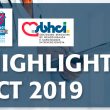Low-dose colchicine seems to reduce the risk for new cardiovascular events in patients with a history of infarction. This drug is usually indicated for anti-inflammatory therapy in gout and pericarditis. Now, it could also reduce the rate of ischemic events as secondary prevention according to the COLCOT trial presented during the American Heart Association (AHA)...
Venous Pulmonary Waveforms in MitraClip Have Prognostic Value
Courtesy of Dr. Carlos Fava. The MitraClip has been shown to benefit a certain group of patients and it is a well-known fact that a ≥5 mmHg is associated to a more torpid evolution. However, there is little evidence when it comes to venous pulmonary waves, changes in left atrial pressure and V wave. 121...
1000 MitraClips: Results from the World’s Most Experienced Site
In September 2008, interventional physicians at the Heart and Vascular Centre Hamburg conducted the first MitraClip implantation after its Conformité Européenne (CE)-marking approval. In July 2019, the same site reached an amazing milestone, 1000 MitraClips implanted, and in doing so it became the most experienced site in the world. Those 1000 patients treated had an average logistic...
TCT 2019 | EXCEL: Left Main Coronary Artery Angioplasty with Favorable Results at 5 Years
Courtesy of Dr. Carlos Fava. Unprotected left main coronary artery angioplasty with drug-eluting stents has emerged as an acceptable strategy for a select group of patients, with results comparable to those of myocardial revascularization surgery at 2 or 3 years. However, beyond such term, we had no valid information. Researchers analyzed the 5-year follow-up results for the...
Very Encouraging Results for TAVR in Low-Risk Patients
Courtesy of Dr. Carlos Fava. About 12% of patients >75 years old have aortic stenosis. In 3%-4% of them, such disease is severe. Transcatheter aortic valve replacement (TAVR) has already proven to be beneficial for extreme-, high-, and intermediate-risk patients. Regarding low-risk patients, we currently have different analyses; two of them are randomized and their results are...
Do Polymers Play any Role in Drug Eluting Stents
The fact that polymers can degrade after drug release seems interesting, more so when there appears to be evidence that they might cause inflammation (manly eosinophil infiltration) given its unwanted consequences. However, nice theories often get a reality check, and the polymer discussion is no exception. This article, soon to be published in J Am...
The Real Impact of Peripheral Artery Disease in TAVR
Courtesy of Dr. Carlos Fava. The real incidence of peripheral artery (PAD) disease in TAVR remains unclear. Different reports still estimate it is between 10 and 46%, but they have shown it has a negative impact in evolution. 51,685 TAVR patients were analyzed. 12,740 of these patients presented PAD (24.6%). PAD patients tended to be...
Permanent Carotid Coil Filters in Patients with Atrial Fibrillation
This new strategy to reduce the risk of stroke in patients with atrial fibrillation is technically feasible and safe, even though long-term outcomes are yet to be seen and despite the evidence available, for instance, left atrial appendage closure devices. It is true that they could be used simultaneously, but its synergy and cost have...
Cardiovascular Risk, Dual Antiplatelet Therapy, and Age. What Should We Know?
Non-adherence to dual antiplatelet therapy varies with age and patients older than 75 years old are those who discontinue treatment most frequently. However, this characteristic in elderly patients was not associated with more cardiovascular events. Treatment compliance protected patients younger than 75 years old from events, while there was increased cardiovascular risk among this population...
EuroPCR 2019 | TRILUMINATE: Tricuspid Repair with Clip Improves Regurgitation and Quality of Life
Transcatheter therapy offers a promise for a largely forgotten valve given the lack of therapeutic options. Percutaneous edge-to-edge repair with clip seems to offer some hope to patients with tricuspid regurgitation according to the TRILUMINATE. At 30 days, transcatheter repair with clip significantly reduced tricuspid regurgitation at least in one grade in most patients, which...








